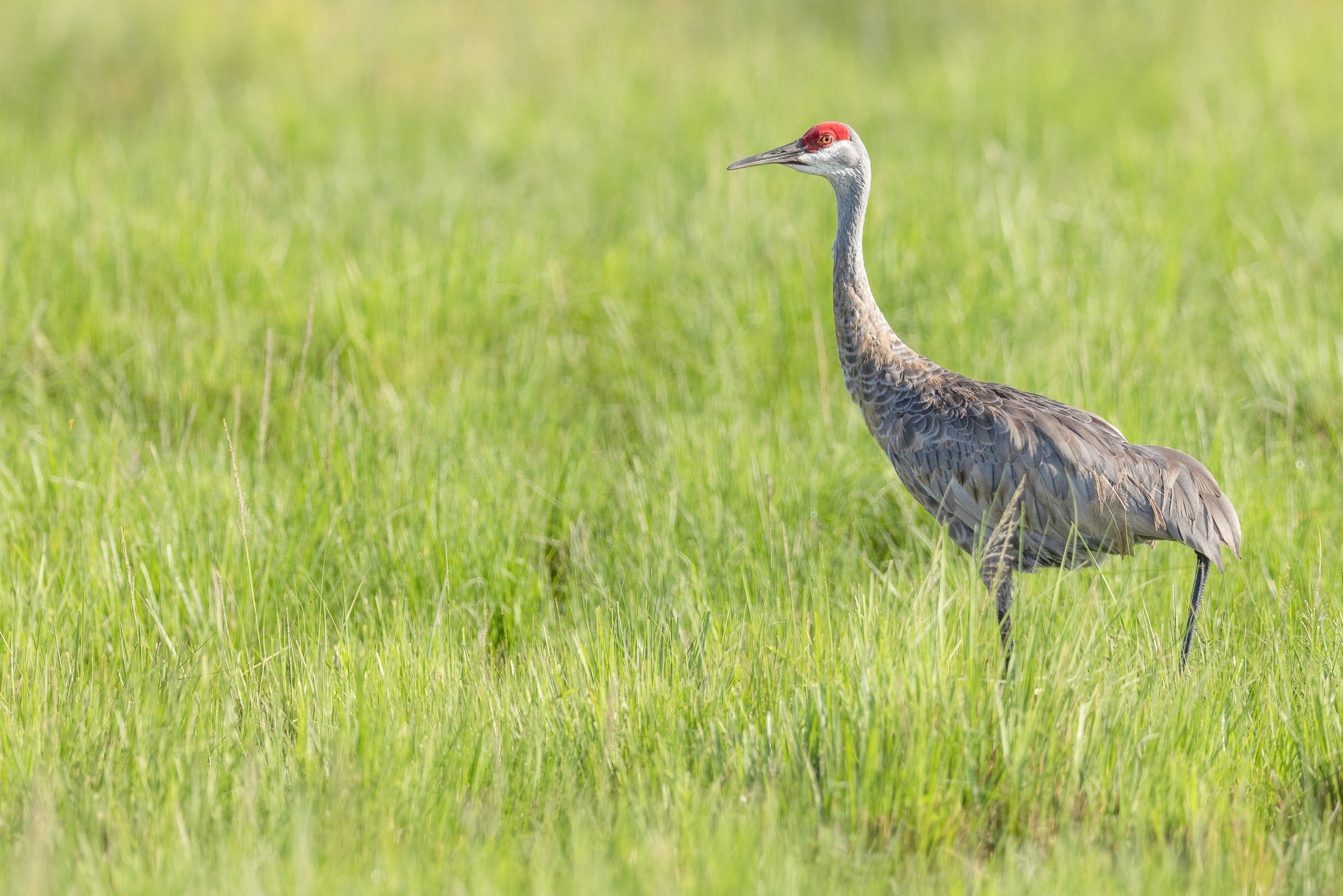Know a Bird - Sandhill Crane
Written By Nancy Vaughan
Well-known to residents of Kansas, the sandhill crane is a twice-per-year migrant through the state, with Quivira National Wildlife Refuge being one of the very best locations in Kansas to see these majestic birds during their migration. Identifiable by their long necks, bills, and legs as well as their red crown, adult sandhill cranes will reach a height of three to four feet, weigh six to twelve pounds, and boast a wingspan of six to seven feet. Although they are estimated to live 15 to 40 years in the wild, they can live twice that long in captivity. They are the most common crane in North America, and the second-tallest bird on the continent, whooping cranes being the tallest. Flocks can have as many as 500 birds, although the norm is 200 to 300. Cranes take advantage of tail winds and thermals, the rising columns of warm air, during their long migration. Cranes are so proficient at riding thermals that they have been seen flying over Mt. Everest, the highest point on earth.
Wintering in warm climates such as Mexico, Arizona, and California, the cranes begin their flight to their breeding grounds in northern regions such as Canada and Alaska around Valentine's Day. With its lush marshes and wetlands, Quivira National Wildlife Refuge is a perfect place for the birds to rest and replenish before continuing their long journey. At night, the waters of the refuge provide protection, as potential predators will disturb that water and alert the cranes to danger. By the conclusion of their northerly migration in April, between 450,000 and 700,000 sandhill cranes will have flown up to 500 miles per day at a speed of 25 to 35 miles per hour, traveling in groups of 100 or more. The sandhill crane flock is known by various names, including "construction", "dance", "sedge", "siege", and "swoop.” Kansas does not typically see as many sandhill cranes during the fall migration south in October and November.
The music of the sandhill crane is distinct, variable, and resounding, with calls that can be heard up to a mile away. The calls can be described as a deep trumpeting or bugling at times, while on other occasions it can sound like trilling, rattling, purring, hissing, or scraping. Although the sandhill crane's vocalizations are not clearly understood by humans, it is thought that purrs are used in calling their young, prior to flight or mating, or when the crane is nervous. Mated cranes have a special unison call that they sing during courtship. This involves the female making a two-note call in response to the male's one-note call.
Another way that cranes communicate is through unique body language called displays, and through dancing, which is most prevalent during courtship and the mating season. The dances can appear comical and awkward, like a gangly teenaged boy trying to impress a girl, but oftentimes are quite elegant as they bow, leap, twirl, stretch their necks, show off their wings, and bob their heads. Their elaborate dances have proven to be an inspiration for artists, dancers, and choreographers.
Sandhill cranes mate in the winter months from November to January and lay their eggs during February, March, and sometimes April. They return to the same general location year after year, usually building their nest in the same or similar spot. Their nests, constructed by both the female and the male, are nearly four feet in diameter. The eggs are up to six inches in length, and the female usually lays two of these. The incubation of the eggs lasts approximately 29 to 32 days, during which the adult cranes, who share the incubation duties, lose up to a third of their body weight. The chick, or “colt,” as baby sandhill cranes are called, is able to swim just eight hours after hatching. It is fed by its mother, or “mare,” and father, or “roan,” for about four weeks and is able to fly when it is nine to ten and a half weeks of age. However, they remain fledglings until they are about ten months of age, at which time they are ready to leave the nest. Because these birds do not mate until they are two or three years old and because they are more likely than other birds to permanently leave the nest when disturbed, their reproductive potential is quite low. This potential is maximized when the nest is built away from human activity in a flat, open area where predators can be seen from a distance. Sandhill crane colts must be able to fly 4000 miles as winter approaches and it is time to return to their warm wintering locations.
It isn't cold weather per se that drives the cranes to leave their breeding grounds and head south. Rather, it's the scarcity of food as insects disappear and other food sources become sparse in the frozen tundra.
Monogamous birds, sandhill cranes usually mate for life. However, if one of the pair dies, then all bets are off and the remaining partner will quickly embark on a search for a new mate.
Sandhill cranes spend most of their day foraging for food. They are omnivores, but the overwhelming majority of their diet is plant material such as grain left in corn fields, berries, nuts, seeds, leaves, and roots. A crane will eat an average of 400, and up to 800, kernels of corn each day during the spring season. The crane smorgasbord also includes small vertebrates such as fish and rodents, and insects such as flies and grasshoppers. Mollusks and crustaceans might also be on the menu. They will sometimes dig in the soil in search of food, and may cause crop damage as a result. On the other hand, they will also eat insects and rodents that can damage crops. The sandhill crane's sharp, robust bill with serrated edges is instrumental in foraging, especially in frozen ground.
On the flip side, sandhill cranes are a food source for other species. Some of their predators include raccoons, wolves, coyotes, foxes, hawks, eagles, and humans. Considered to be the tastiest migratory bird, they have earned the moniker “ribeye of the sky”. Those who have eaten them describe them as tasting like pork. However, sandhill cranes are definitely not passive victims of their predators. When threatened, a crane can be an intimidating opponent, using its feet, beak, and heft to claw, slam, and stab. The very sharp claws on each of its six long toes are used not only for food foraging but also self-protection and defense of its young. A multipurpose tool, its strong, pointed bill is used for preening, digging for food, and also stabbing predators.
Sandhill cranes do most of their feeding, courting, and fighting with other sandhill cranes at sunrise and sunset. They are also generally more vocal during these times. These are the best times of the day to observe crane behaviors.
The Sandhill crane has impressive eyesight. Whereas humans have three types of cones in our eyes which afford us the ability to see approximately two to three million colors, the crane has five types of cones and can see an estimated 100 million colors.
The sandhill crane is not a listed endangered species, but is considered to be climate-threatened, and it is estimated that they will lose 50 percent of their range by 2080 if the current rate of climate change is not remedied. It is vital that wetland habitat in Kansas such as the Quivira National Wildlife Refuge and Cheyenne Bottoms be maintained and protected, as sandhill cranes are especially vulnerable to loss of habitat in their migratory staging areas. Conservation of these areas is critical for sandhill crane populations. Wetlands are critical to the well-being of sandhill cranes, as well as many other birds.
Sandhill cranes are monomorphic, meaning that it is difficult to distinguish female from male by appearance alone, unlike many bird species in which the male tends to be more colorful. Male sandhill cranes are larger than females, and the genders of mated pairs can be determined by their aforementioned unison call.
The Sandhill Crane migration is a breathtaking sight, bringing birdwatchers from distant locations to witness one of the most spectacular animal migrations in North America. If you aren't fortunate enough to live near the sandhill crane migratory route, consider making arrangements to stay at Birdhouse.farm for an up-close look at this amazing spectacle.



